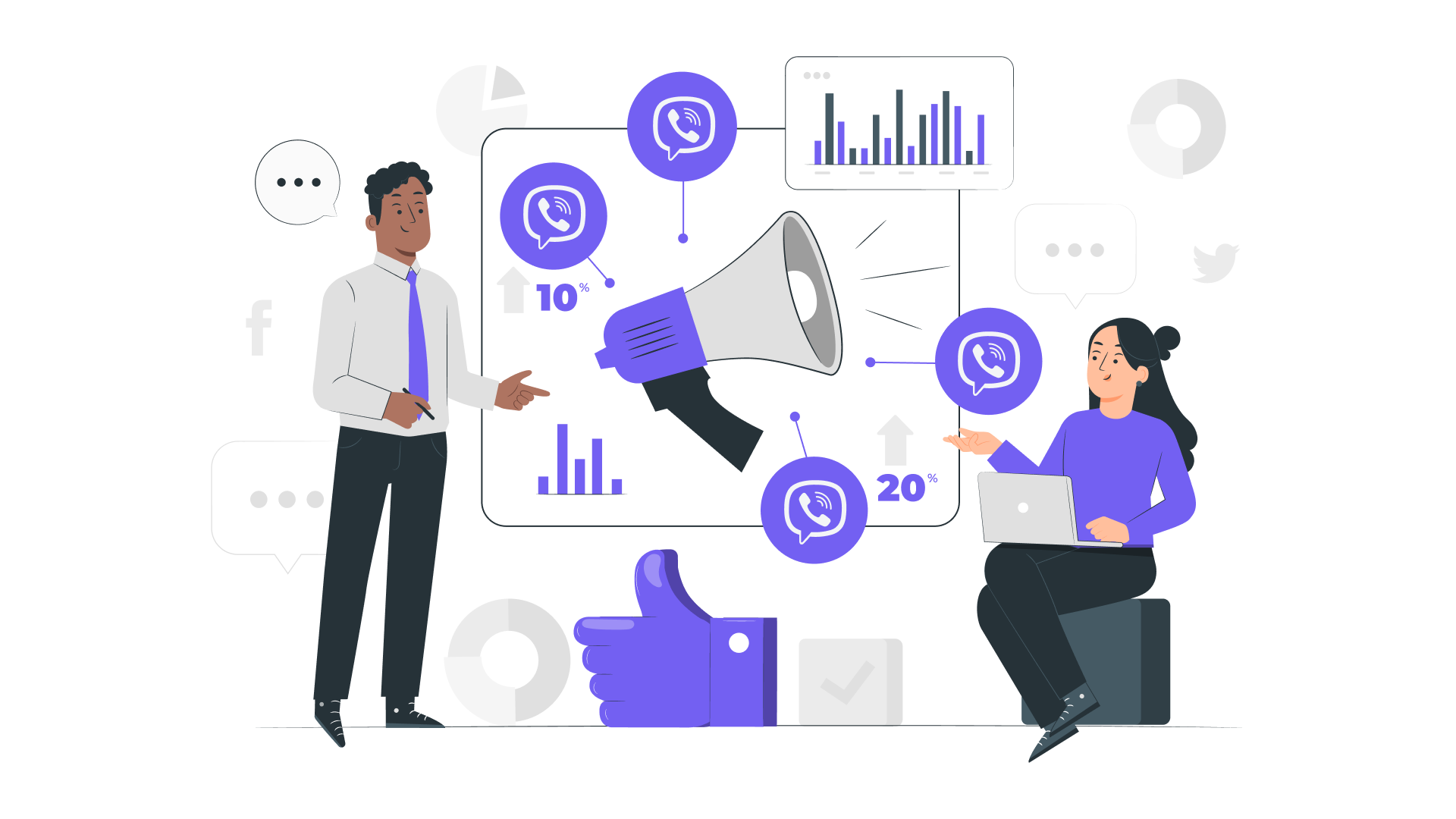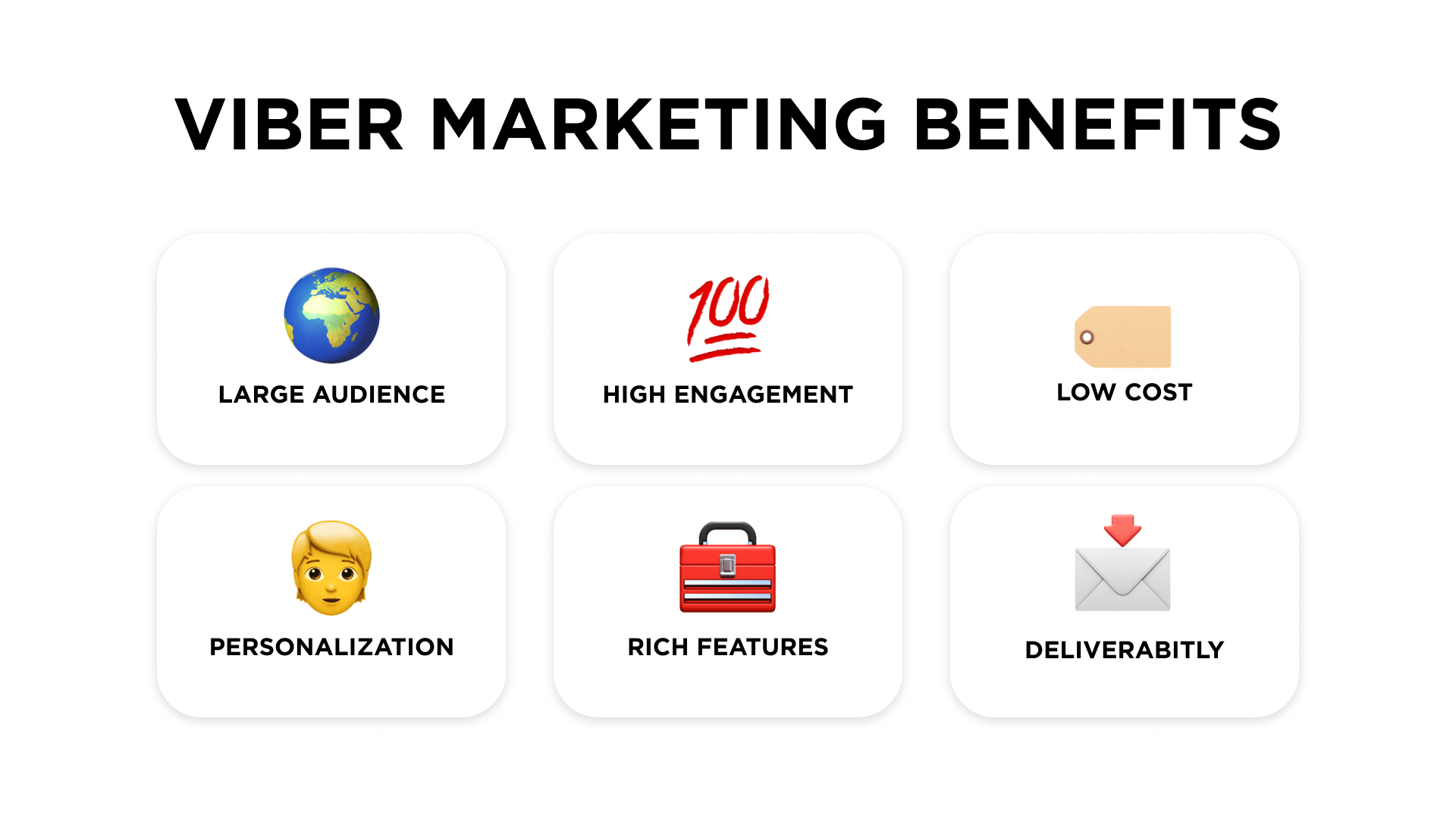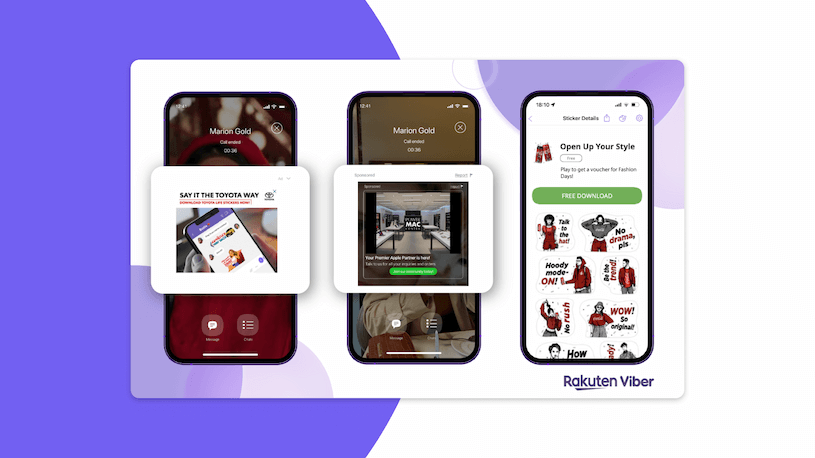The Ultimate Guide to Viber Marketing
Master customer communication via the popular messaging app.

Viber marketing gets exceedingly popular and it is easily explainable. With a user base exceeding 1.1 billion registered users, Viber is among the most popular messaging apps. Its popularity is especially notable in certain regions of Asia and Europe, surpassing even the current king of instant messengers — WhatsApp. Users rely on Viber for a range of daily activities, from socializing with friends and managing work, to consuming content and checking news. If your business targets any of Viber-heavy markets it is a no-brainer to include this channel in your marketing strategy.
In the article, we will discuss how Viber marketing works, its benefits for enterprises in various industries, and share tips on how to use the messaging app for customer communication in the most effective manner.
What is Viber marketing
Viber marketing is the practice of using the features of the popular messaging app to promote products and services, attract leads, and connect brands with customers.Initially launched in 2010 as a simple messaging and voice call app, Viber has since evolved into a multifaceted platform that offers a business multiple ways to engage with its audience, such as direct messages, group chats, chatbots, and interactive content such as polls and stickers. Today, Viber is not just a communication tool but a robust marketing platform that allows businesses to effectively engage their customers on each stage of their journey.
Who can use Viber marketing
Viber marketing is an approach that allows brands in various spheres and of various sizes to engage with their customers on a personal level by sending them personalized messages and engaging content directly via their preferred messaging app.
Thanks to Viber's support of multimedia, a brand can showcase its products or services with visually appealing messages that include images and videos — this is especially useful for B2C brands. Meanwhile, upscale or local companies can achieve that personal feeling by communicating with clients in a messaging app that they already use in their daily lives.
Benefits of Viber marketing for business
Let's take a look at some of the key benefits that companies can enjoy by leveraging Viber for their marketing.

Large audience
If you're not very familiar with the platform yourself, you may ask yourself "Does anyone use Viber anymore?". However, the answer is definitely "Yes". While the app may lose in total numbers to such giants as WhatsApp or WeChat, an audience that counts a billion is something you can't easily dismiss. The most defining trait of Viber is that its audience tends to be less equally represented around the globe, as its popularity tends to be concentrated in such regions as Eastern Europe, some parts of Asia, and the Middle East.
High engagement rates
Viber messages, like those from other popular messaging applications, often have greater open and engagement rates than traditional email or SMS marketing campaigns. As Viber itself states, 96% of messages are read within three minutes on mobile devices. This makes it easy for firms to get their target audience's attention.
Cost-effective
Viber is a cost-effective marketing channel for companies wishing to reach a big audience, especially in places where the app is popular. It offers an attractive alternative to traditional marketing channels thanks to its ability to target certain demographics, various marketing tools, and the capacity to develop and distribute content at a low cost.
Personalization
Viber marketing enables businesses to tailor their outreach by segmenting the audience based on shared characteristics and interests. This allows them to create and deliver messages that are highly relevant to each group's specific needs and preferences, leading to increased engagement, conversions, and customer satisfaction.
Rich features
Viber enables real-time, two-way communication, allowing businesses to quickly respond to customer inquiries, gather feedback and build stronger relationships. Viber's features, such as public chats and communities, help build community and brand loyalty. In addition, its ability to integrate with other digital platforms and provide access to data analytics makes it easier for businesses to optimize their marketing campaigns efficiently.
Message deliverability
Viber Business Messages ensure the deliverability of customer communications by offering a fallback to the SMS mechanism. If a message sent via Viber can't be delivered within a set time, it's automatically converted to an SMS. Users can define a maximum time window (TTL) for Viber delivery, and if the message isn't delivered within this window, it switches to SMS mode. This guarantees that recipients receive important messages even if there are issues with internet-based delivery.
How to use Viber marketing
Viber offers three message types for companies:
- Transactional messages are those related to specific transactions or actions. Those can be delivery updates, purchase receipts, or registration confirmations.
- Conversational messages allow businesses to engage in ongoing conversations with customers. Examples include customer support interactions and collecting feedback and reviews.
- Promotional messages are used for marketing purposes. These include informing customers about new product launches or special offers, as well as communications aimed at re-engaging inactive customers.
There are two types of integration options available for business on Viber that both support all of the three types of messages.
- Business Messages allow a company to directly connect with the business, initiate conversations, and deepen connections with the existing customer base while combining text, images, files, and call-to-action (CTA) buttons.
- Chatbots can be seamlessly integrated into conversations with clients, offering a customizable user keyboard as well as automation to qualify and convert leads into new paying customers and streamline interactions with existing ones.
To start using Viber’s capabilities for business, a company must choose a partner from a list of trusted companies who can guide it through the process. Such a partner helps to get started with Viber marketing, as well as perform the business account setup, providing either a self-service platform or a dedicated API to connect to the company's own CRM system. This step ensures seamless integration and efficient communication. Additionally, obtaining a verified status on Viber is crucial. Viber reviews applications for the blue tick (official verified status) on a case-by-case basis, so the review time may vary. Once approved, the company’s profile receives this blue tick next to its channel name.
After setting up a business account and obtaining consent from customers on Viber for communication, a company can start sending both promotional and transactional messages. This also allows the company to engage in dialogues with clients via conversational messages.
Viber Marketing best practices
To successfully leverage Viber marketing, the following aspects play the utmost importance in shaping promotion and communication activities on the messenger.
Personalize communication
Customers today value authenticity and personalized experiences. Use Viber's features to segment your audience and personalize messages based on their interests. Simple, personalized touches, such as birthday wishes, special offers based on previous purchases, or addressing customers by name, can greatly improve customer loyalty.
Utilize data
Data is key to successful Viber marketing. Use the analytical insights provided by the messaging app to improve your approach to communication and campaign design. Regularly monitor key performance indicators, including cost per acquisition, customer lifetime value, average order value, and user engagement.
Aim for consistency
Building a loyal Viber community requires a long-term commitment and consistent effort. Establish a regular content calendar and stick to it. This way, the brand will always be on the minds of that part of its audience that uses Viber. Remember, trust and loyalty are built on consistent behavior.
Implement Viber bot
Creating a Viber chatbot allows you to automate client contacts, handle booking confirmations, collect feedback, and promote new goods, all while providing customers with a smooth experience. The advantages of deploying a Viber bot for marketing include efficiency, 24-hour availability, personalization, and cost-effectiveness.
Use compelling CTAs
Each communication sent via Viber should clearly state the desired action, whether it is visiting a company’s website, making a purchase, or downloading an app. Use strong action verbs, create a sense of urgency, and highlight the benefits the audience will receive. Also, don’t forget to test different approaches to find the most effective strategy.
Custom sticker packs
Businesses on Viber can create their own sticker packs and share them with other users of the app, which is a great way to promote certain products and services without resorting to straightforward ad campaigns.
For example, in Bulgaria, Coca-Cola launched a branded sticker pack with promo codes and a chatbot experience on Viber, promoting it across their social media channels and tying it into an "under-the-cap" sweepstakes. This resulted in over 191,000 sticker pack downloads, 184,000 chatbot subscribers, and 29,000 redeemed cap codes, while the campaign achieved a 30% conversion rate – ten times higher than the industry average.

Viber ads and communities
Creating ads on Viber and engaging with communities can significantly boost the brand’s visibility. Advertising formats on Viber include sponsored messages integrated within the chat interface, public chat ads embedded in company-managed groups, video and dynamic rich media ads with interactive elements, which increase the brand’s visibility and can be tailored to individual user preferences. Meanwhile, engaging with the audience through community channels is an effective way to foster meaningful conversations and build brand loyalty.
Conclusion
Given Viber's impressive popularity in numerous regions worldwide and its extensive functionality for business, the messaging app has the potential to serve as an efficient channel for customer communication for brands across various sectors.
Leveraging the capabilities of the Umnico allows you to combine client conversations from over 25 popular instant messengers and social media, along with VoIP and live chat widgets, in a single interface. Additionally, an intuitive chatbot builder makes it easy to create bots based on GPT-4 technology and integrate them in the chosen communication channel. Enhance your customer engagement with Umnico all-in-one messenger – try the platform for free today.

Subscribe to Umnico news!
Be the first to get recommendations and up-to-date information
